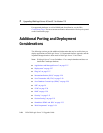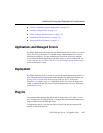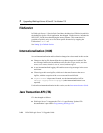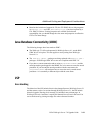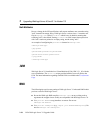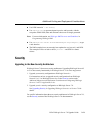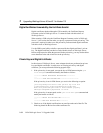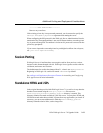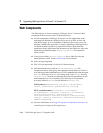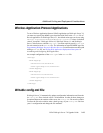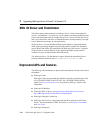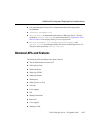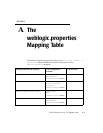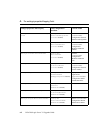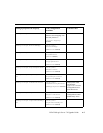
2 Upgrading WebLogic Server 4.5 and 5.1 to Version 7.0
2-34 BEA WebLogic Server 7.0 Upgrade Guide
Web Components
The following tips are for users porting to WebLogic Server 7.0 who used Web
components in their previous version of WebLogic Server:
All Web components in WebLogic Server now use Web Applications as the
mechanism for defining how WebLogic Server serves up JSPs, servlets, and
static HTML pages. In a new installation of WebLogic Server, the server will
configure a default Web Application. Customers upgrading to WebLogic Server
7.0 should not need to perform any registrations because this default Web
Application closely approximates the document root, the JSPServlet, and servlet
registrations performed using the
weblogic.properties file contained in
earlier versions.
Convert your existing weblogic.properties file to XML files using the
Administration Console. See the Console Help for more details.
SSI is no longer supported.
URL ACLs are deprecated. Use Servlet 2.3 features instead.
Some information has moved from web.xml to weblogic.xml. This
reorganization allows a third-party Web application based strictly on Servlet 2.3
to be deployed without modifications to its J2EE standard deployment descriptor
(
web.xml). WebLogic Server 5.1 style settings made in the web.xml file using
<context-param> elements are supported for backward compatibility, but you
should adopt the new way of deploying. The following sets of parameters
previously defined in
web.xml are now defined in weblogic.xml:
JSP Parameters (
keepgenerated, precompile compileCommand,
verbose, packagePrefix, pageCheckSeconds, encoding
)
HTTP sessionParameters (
CookieDomain, CookieComment,
CookieMaxAgeSecs, CookieName, CookiePath, CookiesEnabled,
InvalidationIntervalSecs, PersistentStoreDir,
PersistentStorePool, PersistentStoreType, SwapIntervalSecs,
IDLength, CacheSize, TimeoutSecs, JDBConnectionTimeoutSecs,
URLRewritingEnabled
)
For more information, see Writing Web Application Deployment Descriptors in
Assembling and Configuring Web Applications.



